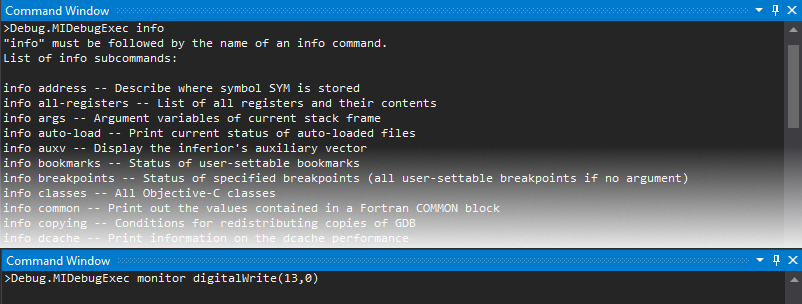

- Gdb and visual micro tutorial install#
- Gdb and visual micro tutorial update#
- Gdb and visual micro tutorial software#
- Gdb and visual micro tutorial series#
- Gdb and visual micro tutorial download#
CYCLONE and CYCLONE FX series programmers can easily be automated, or operated manually in stand-alone mode to securely program target devices. The tools are seamlessly integrated into a variety of popular 3rd party IDEs, as well as through an Eclipse-based plug-in which integrates these tools into any GDB-based Eclipse IDE.įor production, Pemicro's Cyclone ISP programmers are some of the fastest and most sophisticated and secure programming tools on the market. On the development side, PEmico’s Multilink debug probes support many advanced debug features including power measurement, real-time expressions view, SWO data capture, and printf capture. Today, PEmicro continues this universal programming philosophy with its flagship products for both Advanced Debug and ISP Production Programming tools. Incorporated in 1982, PEmicro developed and marketed the first-of-its-kind general purpose programmer, with reconfigurable outputs to allow engineers to use a single tool to program memory from a wide variety of device manufacturers. PEmicro is an industry trendsetter in Debug and ISP Programming tools for a wide variety of ARM® devices.
Gdb and visual micro tutorial update#
The latest P&E GDB Server plugin can be installed by Eclipse automatically (Help->Install New Software.) via the following update site. For user's of Eclipse based development IDEs such as KDS (Kinetis Design Studio), S32 Design Studio for ARM, LPCExpresso, SOMNIUM DRT, etc. PEmicro's GDB Server for ARM devices is available as an Eclipse plugin that can easily be installed within Eclipse IDE under Windows, Linux, and macOS operating systems.


While the main device core is used to load multiple. This powerful feature allows user to debug multiple device cores concurrently. Real Time Expressions dialog allows users to see updated variable values as the target is running. This information is then used to dynamically populate the Eclipse views as the user navigates between the threads. Using these discovered symbols, the debugger can traverse the kernel's internal data structures to enumerate the available threads and their corresponding execution context. The GDB server will automatically detect the presence, type, and configuration of an OS by the querying the application's symbol table for identifying characteristics.
Gdb and visual micro tutorial software#
The latest version of the software contains the following features: Click for a complete list of ARM devices that are supported. PEmicro's GDB Server supports run control and FLASH programming of many ARM devices. NXP's Kinetis Design Studio, MCUExpresso IDE, and S32 Design Studio already have the plugin seamlessly built into their products.
Gdb and visual micro tutorial install#
The server is available as an Eclipse plugin so the user can easily install and configure it. PEmicro's GDB Server supports Multilink, Cyclone and OpenSDA debug hardware interfaces.
Gdb and visual micro tutorial download#
PEmicro's GDB Server is available to download at no cost. P&E's GDB Server is the piece which links the GDB debugger to the P&E hardware, allowing debug and programming via USB, Serial, and Ethernet buses.

GDB is a freely downloadable software debugger that, when paired with debug hardware, provides debug capabilities including flash programming, execution control, breakpoints, watchpoints, stepping, and value inspection.


 0 kommentar(er)
0 kommentar(er)
